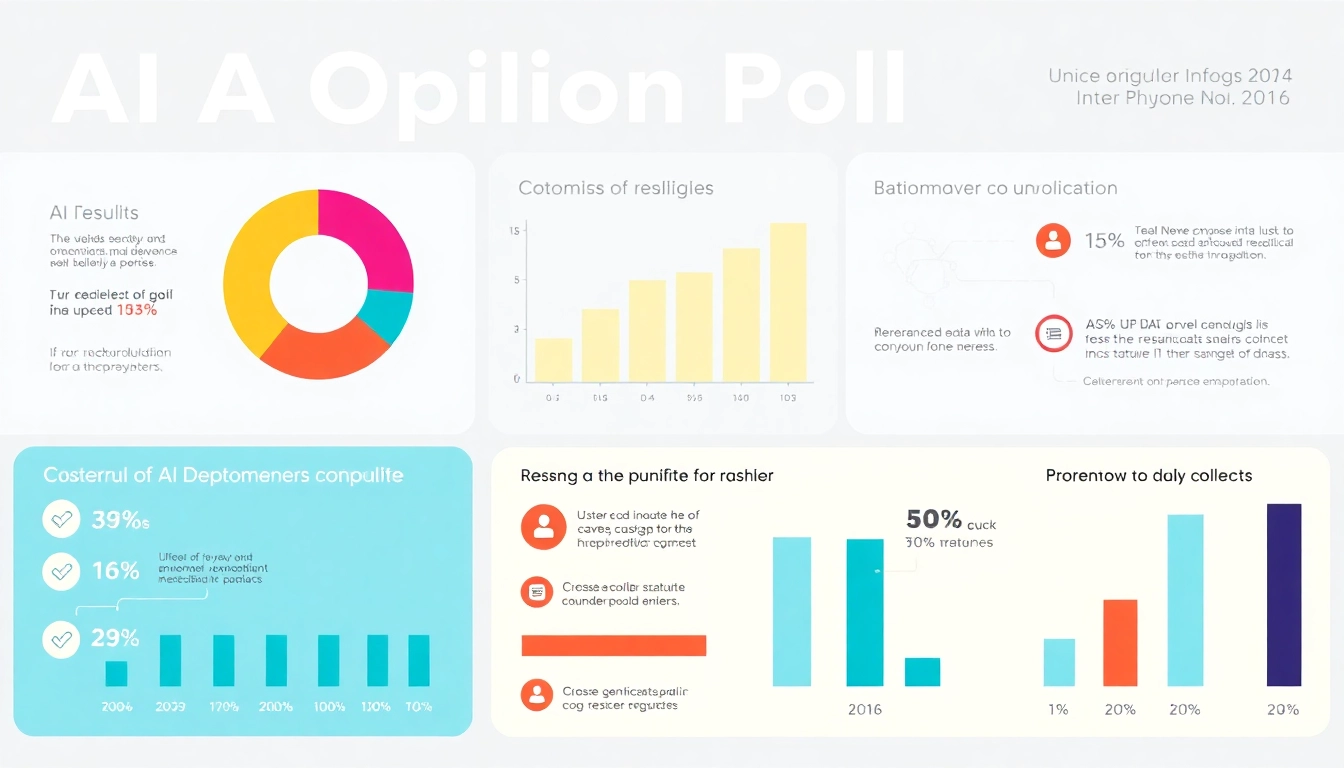Understanding the Landscape of AI Opinion Polls
Artificial intelligence (AI) has become a focal point of discussion across various sectors, sparking a myriad of opinions and sentiments. Conducting an AI Opinion poll can provide valuable insights into how people perceive the advancements in AI technology, its implications in daily life, and its broader impact on society. Understanding public sentiment is crucial not only for technologists and policymakers but also for businesses aiming to leverage AI for strategic development. This section delves into what AI opinion polls are, their significance, and current trends observed within public sentiment surveys.
What are AI Opinion Polls?
AI opinion polls are surveys designed to capture the public’s views regarding artificial intelligence. These polls systematically collect data from a sample population, asking questions that gauge their attitudes towards AI’s effectiveness, safety, implications for the job market, ethical considerations, and overall societal impact. The results reflect a spectrum of opinions – from excitement about innovations and efficiencies brought by AI to concerns regarding privacy, misinformation, and job displacement.
The Importance of Public Sentiment in AI Development
Public sentiment plays a pivotal role in shaping both the development and deployment of AI technologies. As AI systems increasingly influence critical societal domains—ranging from healthcare to finance—understanding public opinion can guide responsible innovation. Public trust in AI can lead to higher acceptance rates, while skepticism may prompt calls for regulatory measures, ethical guidelines, and transparency in how AI systems operate.
Recent Trends in AI Public Opinion Surveys
Recent surveys reveal shifting trends in how the public perceives AI. For instance, a notable percentage of respondents express apprehension about AI’s role in perpetuating misinformation and privacy breaches. Surveys from reputable sources such as Pew Research Center indicate a growing disconnect between enthusiasm for AI technology and apprehension about its consequences. Regularly tracking these sentiments equips stakeholders with the necessary insights to forge pathways that address public concerns while showcasing the benefits of AI.
Key Findings from Current AI Opinion Polls
Concerns vs. Excitement: The American Perspective
According to the latest polls, a significant portion of the American population displays concern about the impact of AI on daily life. For example, a study published by Pew Research highlighted that 52% of respondents are more worried about AI’s implications than excited about its potential benefits. This sentiment is echoed across demographics, showcasing a robust hesitancy toward fully embracing AI technologies.
Impact of Gender on AI Opinions
Gender dynamics also play a critical role in shaping AI opinions. Surveys indicate that women tend to express more cautious perspectives on AI compared to men. Recent findings from Gallup and other institutions show that women are more likely than men to identify the risks associated with AI, including job loss and ethical dilemmas. Understanding these differences is essential for targeting educational campaigns aimed at increasing public awareness and acceptance of AI.
How Economic Factors Influence Public Sentiment
The economic climate bears significant influence on public attitudes towards AI. In times of economic instability – such as during recessions or significant market shifts – concerns regarding job security take precedence. Many Americans fear that AI will exacerbate unemployment, a sentiment corroborated by multiple studies. Understanding these economic sentiments helps policymakers and AI developers address these concerns through communicative strategies that highlight the transformative potential of AI in aiding job creation and enhancing productivity.
Analyzing Public Sentiment: Data-Driven Insights
Statistics from Recent AI Polls
Data from recent AI polls showcases a variety of statistics that reveal public opinion trends. For instance, a survey conducted by a national news organization found that 68% of respondents either use AI tools at work or are familiar with AI technologies. However, nearly half report feeling anxious about these technologies’ long-term implications. These statistics provide a rich context for understanding the duality of acceptance and apprehension surrounding AI, highlighting areas where further education and communication are needed.
Visual Representation of Public Opinions
To better grasp public sentiment towards AI, visual data representation can be an effective tool. Graphs, pie charts, and infographics encapsulate complex survey responses into understandable visuals. For instance, a pie chart depicting the percentage breakdown of positive vs. negative opinions on AI can immediately convey the prevailing sentiment and highlight discrepancies that merit further exploration.
Comparative Analysis with Previous Polls
Establishing a comparative analysis with prior AI opinion polls enables observers to identify trends and regularities over time. For example, polling data from 2023 contrasted with surveys carried out in previous years reveal that skepticism surrounding AI has increased significantly. By continuing this analysis, stakeholders can detect patterns in sentiment shifts and adapt accordingly, ensuring that AI development aligns with public expectations and concerns.
Challenges Facing the AI Industry in Response to Public Opinion
Identifying Fears: Job Loss and Misinformation
Central fears expressed by the public regarding AI revolve around job loss and misinformation. For many workers, especially in automatized industries, AI poses a direct threat to their job security. Furthermore, concerns about AI’s capability to spread misinformation are widespread, as algorithms can sometimes amplify false narratives if not properly managed. Addressing these fears is essential for the AI industry to foster public trust and acceptance.
Building Trust: Strategies for AI Development
Trust-building strategies are essential for aligning AI developments with public expectations. Open communication regarding the capabilities and limitations of AI, coupled with increased transparency in algorithmic decision-making, can alleviate concerns. Additionally, initiatives that showcase AI’s potential to create jobs rather than eliminate them may help reshape public perception positively.
Engagement with Stakeholders and the General Public
Effective public engagement strategies must be a priority for AI developers. Organizing town halls, community forums, and industry-specific workshops can offer platforms to discuss AI’s societal implications. Engaging key stakeholders—such as policymakers, educators, and industry leaders—ensures a multifaceted conversation that incorporates diverse perspectives, enhancing the credibility of AI technologies.
The Future of AI Opinion Polling and Public Engagement
Emerging Questions for Future Surveys
As AI technologies evolve, new questions will surface within public sentiment surveys. Future polls may explore topics such as opinions on AI regulations, ethical considerations for AI in social media, and the societal impacts of AI-driven decision-making in essential services like healthcare. Crafting insightful questions that resonate with current public interests is crucial for staying ahead of emerging sentiments.
Impact of Social Media on AI Perception
Social media has a significant impact on how the public perceives AI. Platforms like Twitter, Facebook, and Reddit facilitate rapid sharing of information and opinions. This can lead to heightened awareness of risks and benefits associated with AI, influencing public opinion in real-time. As such, monitoring discussions on these platforms can provide invaluable insights for understanding shifts in public sentiment.
Final Thoughts: Bridging the Gap Between Technology and Society
The evolution of AI and its acceptance hinges upon maintaining a continuous dialogue between technologists and the community. Comprehensive polling enables insight into public opinion, providing a roadmap for managing risks while enhancing the benefits of AI technologies. As AI continues to permeate various aspects of life, fostering understanding, transparency, and public engagement will be vital in shaping a harmonious relationship between technology and society.



